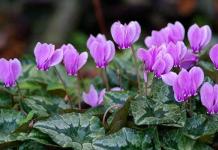Evgeny Sedov
When hands grow from the right place, life is more fun :)
This perennial root plant belongs to the Mirsinov family and is common in Iran and African countries. The flower has other names - alpine violet or dryakva. When buying, many do not know how to care for cyclamen at home, and caring for it has some features. Alpine violet loves good lighting and moist air. This beautiful indoor flower with red flowers is increasingly appearing on the shelves of greenhouses as it blooms in winter, creating a pleasant and joyful atmosphere with its bright petals.
Cyclamen Care
Many beginning flower growers have a question - how to care for cyclamen flowers at home? There is an opinion that this plant is finicky and demanding, and it is very difficult to take care of it - in an apartment, a mountain plant does not bloom well, suffers from incurable diseases. In fact, the opposite is true - cyclamen at home is unpretentious, and the problems associated with it often occur due to flower growers' ignorance of how to water, grow, propagate and protect a flower from pests.
Alpine violet has more than 20 species, but two of them are the most popular in room culture: Persian and European cyclamen. The life of the plant is contained in the tubers, since there are all the nutrients that help the dryak to survive in the dormant period. The growth and flowering of cyclamen falls at the time from October to March, and the rest of the time it rests. Therefore, it is very important to know the nuances of proper care for alpine violets: how often to water, where it is better to put, what temperature is needed.
During flowering

During this period, the plant needs a room with bright lighting and moderate watering. The flower prefers coolness (12 - 15 degrees Celsius), so florists do not recommend placing cyclamen in a pot close to batteries or lamps. Alpine violet loves bright, diffused lighting, but not sunny - burns may appear on the leaves, and they will begin to turn yellow. Clean air and optimal humidity (50%) will help the plant to maintain flowering and healthy appearance, as well as avoid diseases.
Watering cyclamen should be moderate and regular, with water at room temperature. When carrying out this procedure, it is advisable not to spray the leaves and tubers, since excessive moisture leads to rotting of the plant. The best option is to carefully pour water into the edge of the pot. Cyclamen European or Persian during flowering must be fertilized every two to three weeks. Top dressing should not contain a lot of nitrogen, as this leads to the growth of leaves, not buds and flowers.
After flowering

A cycle of active growth and blooming (3-4 months) is followed by a dormant period. At this stage, cyclamen "sheds" the flowers and leaves, which begin to turn yellow, and die off after the next two months. Throughout this period, it is necessary to gradually reduce the watering of the plant to a minimum - excessive moisture leads to rotting of the tuber. During the dormant period, the alpine violet is moved to a cool place with low light.
How to transplant cyclamen

Toward the end of summer, it is advisable to transplant alpine violet into fresh soil. This procedure has its own characteristics. Before transplanting cyclamen, it is necessary to prepare the soil, which contains: two parts of peat, leaf and sod land, one part of sand. It is necessary to transplant into a flowerpot carefully so that the roots are not damaged. It is desirable to treat the earth with a solution of potassium permanganate and steam it, since this houseplant is easily affected by various pests. Bury the tuber not completely - the roots are at the bottom of the cyclamen - they need a place to grow.
Reproduction of cyclamen
It is really possible to carry out this procedure on your own at home, but in order for it to work correctly, you should know how cyclamen reproduces. There are two ways - by seeds or vegetatively (tuber division). Alpine violet is very sensitive to all sorts of interference, so both breeding processes should be carried out carefully. Florists advise beginner gardeners to buy cyclamen mini mix and experiment. This set includes plants with two or three tubers, which will allow several propagation operations.
tubers
The vegetative method of division is traumatic for the plant, so it is rarely used indoors. The root crop of cyclamen does not give shoots - you have to cut the mother tuber, which threatens to rot the entire flower. For this procedure, old plants are taken, which are several years old. In order for the division process to be successful, it is necessary to carry out a number of operations:

- Wait until the leaves of the plant have completely died.
- Carefully remove the tuber from the pot and free from the soil.
- Propagate the tuber with a clean knife from top to bottom so that each part has roots.
- Treat with fungicides (antifungal chemicals) and let dry.
- Plant in different pots.
Growing cyclamen from seeds
How to grow this plant from seeds? Very simple. This method of propagation of alpine violets is more common and not as complicated as vegetative. To obtain cyclamen seeds at home, it is necessary to artificially pollinate the plant. To do this, you need a soft brush, which gently applies pollen from one flower to another. After some time, seeds are born. Their cyclamen hides in a small box under the leaves closer to the ground. It is desirable to get the fruits before the moment when they fall into the ground - ripening occurs before the start of flowering of the alpine violet.

It is best to sow cyclamen seeds when spring comes, after soaking them with a preparation that accelerates the growth of flowers (for example, Epin). Place the fruits in sterile fresh soil to prevent rot. The first shoots will appear 30-40 days after sowing, under conditions suitable for germination and flowering: temperature 18-20 degrees above zero, dark space and moist soil.
Diseases of cyclamen
Alpine violet is a delicate home flower, so it is prone to various diseases. Plant care requires a person to have the skills and knowledge of how to revive a cyclamen if it has begun to fade, or what to do if its leaves have begun to turn yellow. Rot, aphids and mites are one of the main enemies of alpine violets. There are a number of symptoms by which one or another disease of cyclamen is distinguished.
Leaves turn yellow

If this happens, the plant does not have enough light, clean air, or it is hot. When the leaves turn yellow, you should move the flower to a brighter room, but not under direct sunlight. It is better to let the cyclamen “breathe” with fresh air by placing it on the windowsill by the open window. Another reason for the yellowing of the leaves may be insufficient watering of the plant - you should moisten the soil, but do not overdo it. Due to an excess of water, alpine violet will begin to rot.
Leaves are curling

In the process of damage to the flower by pests or the external environment, the leaves of cyclamen may curl. This negative effect can be caused by several reasons:
- The presence of pests (mites, aphids, thrips).
- Home flowers are affected by bacteria or fungus.
- Infection of the soil or its waterlogging.
- High air temperature in the room.
Why is it not blooming

The slowdown in growth and flowering of cyclamen may be due to various reasons. One of the main ones is fusarium. This disease causes damage to the tissues of the alpine violet. With Fusarium, the vessels of the plant are filled with toxic substances. This leads to the fact that cyclamen ceases to bloom, and the leaves turn yellow. The initial lesion is difficult to determine by eye, since the cause of the disease is in the soil or seeds. It is desirable to fight Fusarium with the help of fungicides (for example, Agat-25K), which have a detrimental effect on the source of the disease.
Cyclamen is able to suppress and nullify conflicts, calm capricious children. Cyclamen helps to overcome complexes, isolation, shyness. This flower gives hope to the hopeless.
The Greeks called the flower sleeping in summer cyclamen. It is a perennial plant that forms an almost perfectly round corm. Therefore, the name of this flower comes from the word "cyclos" - a circle. Our ancestors called the delicate flower “pork bread” because wild boars did not disdain its tubers.
The magic of cyclamen
Cyclamen is a sacred plant that brings happiness to the family.. It protects from evil spells, various malevolent messages, envy, obsessions, bad thoughts and dreams. This unusual plant is a must have in the house. And then your family will be under the protection of the goddess Hecate. And this, in turn, means maintaining peace in the family, friendly relations, calmness.
Cyclamen creates a field (with a radius of approximately 5 meters), within which evil forces do not act. And if a negative impact on a person occurred outside this field, then, having fallen into the zone of action of cyclamen, a person is cleansed of the effects of evil forces and spells. Moreover, cyclamen protects only members of the family that owns the flower and cares for it (that is, the effect of the flower does not apply to guests and other visitors to the house).
The main property of cyclamen is the protection of the owner. In order for the plant to fully take you under its care, it must be placed at the head of the bed. It is desirable to place the plant on the right side, at a distance of no more than 1-1.5 meters from the head. Cyclamen has the most beneficial effect on a person when a person is sleeping. It is at this time that the subtle structures of the body are cleansed.
In order not to reduce the magical power of cyclamen, the flower can only be watered from below (in a saucer).
An important factor for the family is that cyclamen relieves the family of despondency and sadness and brings joy to the hearts. The most powerful magical colors of cyclamen are pink and white. Despite the fact that this plant belongs to the elements of water, it has a "fiery flower" - a flame located in the middle of the plant. When you first get a flower and bring the plant home, put it in the right place and look at the center of the plant (under the flower) for 3 minutes. At the same time, one must ask for the protection and patronage of this magical plant. If you have other plants in your house, then keep in mind that cyclamen should be at least 2 meters away from them. If a person has a severe psychological state (chronic stress, depression), then under the influence of the cyclamen field, improvement can occur after 7 nights from the moment the cyclamen is placed in the bedroom.
In addition, cyclamen very effectively cleans the air in the room. Cyclamens bloom in winter. After flowering, cyclamen begins a dormant period, which lasts until June-July. Entering it, the plant begins to lose leaves. Therefore, after the end of flowering, cyclamens are usually thrown away, which is what many modern plant care guides recommend. Actually, you shouldn't do this. After all, this is your protector, the keeper of the family.
Cyclamen refers to "home amulets". Even the ancient Romans believed that it protects from all misfortunes, despondency and sadness.
How to choose cyclamen
In winter, when there are so few bright colors, and most plants do not bloom, cyclamen will delight any connoisseur of beauty. Many compare it to exotic butterflies fluttering over dark green heart-shaped leaves.
Cyclamen blooms for a long time. Depending on the variety and conditions, flowering may begin in the second half of October and last until the end of March.
The most common Persian cyclamen is sold in stores in late autumn. When buying, you should pay attention not only to the leaves of the plant, they should be undamaged, juicy, rich in color and low-lying, but also to the tuber. It should not be wrinkled and without signs of decay. It is correct if the tuber is only half deep in the ground. It depends on this how the plant will develop further. Cyclamen is best purchased at the beginning of flowering. At the same time, it is desirable that the plant has a large number of buds.
Growing cyclamen at home
Temperature. One of the prerequisites for the well-being of cyclamen is a cool temperature: about 12-15 ° C, but not lower than 10 ° C and not higher than 20 ° C.
Lighting. The place for cyclamen should be very light, preferably bright diffused light. Avoid direct sunlight, provide the plant with shade.
Watering. During the growing season, regular watering is necessary, preferably by immersion, when watering from above, it is necessary to ensure that water does not fall on the tuber and leaves, and water is poured to the edge of the pot.
Air humidity. Since cyclamen loves moist air, the pot is placed on a tray with pebbles or wet peat. It is impossible to spray cyclamen, you can only moisten the air around the plant from a very small spray bottle.
Care after flowering. After the Persian cyclamen fades, the flowers are cut to the very tuber, watering is reduced and feeding is stopped. Yellowed leaves are not cut, but twisted along with the petioles. By spring, all the remaining leaves will dry out completely. So the plant goes into a dormant state. Watering stops. The pot is placed on its side, put in a cool place and not watered until mid-summer.
From mid-summer, the pot is placed in a shaded place in the fresh air, the earth is periodically moistened so that it is moderately moist. The appearance of the first leaves is a sign that it is time to transplant the plant.
For other types of cyclamen, it is enough just to unscrew the dried leaves and stop feeding.
Transfer. When transplanting, the old soil is completely replaced. The soil for Persian cyclamen should consist of 1 part leaf, 1 part humus, 1 part soddy soil and 1 part sand. Before transplanting, the root system is checked, all diseased or rotten roots must be removed. The pot for cyclamen should not be very large, the best size is 12-14 cm in diameter. In too small a pot, cyclamen will bloom prematurely and flowering will be weak.
For other species, it is desirable to add ash or dolomite to the soil for a neutral reaction, while the soil for Neapolitan and European cyclamen should be nutritious, for Kos - poor. When transplanting, the tubers of Persian cyclamen are not buried, leaving about a third of the tuber on top, the rest can be buried, and the Neapolitan one must be buried.
After transplantation, cyclamen is placed in a bright place, with shading from direct sunlight, watering the first two weeks after transplantation should be moderate until the plant gets stronger and new leaves sprout.
reproduction. Cyclamen is propagated by tuber division and seeds. Seeds of Persian, European, Neapolitan cyclamen are sown in late summer at a temperature of 15-20°C. Most varieties of Persian cyclamen bloom in 15-18 months, miniature forms in 6-8 months.
Seeds of Kos cyclamen are sown in winter, in January-February. European cyclamen can be propagated by dividing the tuber in February.
Growing cyclamen from seeds is easier if you have an indoor greenhouse (available at any gardening center or flower shop). By the way, cyclamens grown from seeds are more adapted to room conditions than specimens grown in Dutch greenhouses.
Healing properties of cyclamen
Cyclamen has medicinal properties, but is poisonous, so treatment with it requires caution. There are several varieties of this plant, containing different amounts of the active substance and, accordingly, having a different therapeutic effect.
The most commonly used are European cyclamen, known as alpine violet, and Persian cyclamen. Traditional medicine recommends juice and infusion of cyclamen tubers for women's diseases, bladder diseases, colic, rheumatism, osteochondrosis, sciatica, as well as headaches, frontal sinusitis and sinusitis.
In my house there are a lot of flowers of various types and cultures. Cyclamen is in priority for its unsurpassed external data.
You can achieve beautiful flowering only by proper care of the plant, which I will tell you about. First you need to find out what care rules will lead the plant to normal development and active growth in the periods necessary for this. By following some simple rules, you will definitely succeed.
In recent years, the popularity of such a house plant as Cyclamen has been growing right before our eyes. In houses, more often than others, you can find species - European and Persian. These species have incredible flowers, for which these plants fell in love with many novice flower growers, as well as experienced house plant lovers.
Alpine violet, as Cyclamen is also called, is presented in the form of a low bush with surprisingly bright flowers. Violet leaves have a variety of patterns and are the same size. The inflorescences are located above the foliage, different species have large or small flowers.
Cyclamen develops only for a few months of the year. What does the flower do the rest of the time? He is in a dream. To date, it has been possible to breed many types of violets that are able to grow and maintain flowering almost the entire year.
Cyclamen is usually divided into only 2 types and a huge variety of varieties that will differ in their characteristics and appearance.
Proper care
Caring for Cyclamen is not that difficult, but there are a number of rules that should be followed, namely:
- First, find a suitable place to identify the plant. The flower loves a lot of diffused light and does not tolerate drafts;
- Temperature is extremely important for normal flower development. Cyclamen loves cold and cannot withstand high temperatures. The normal temperature will be 15 degrees Celsius;
- In the summer heat, you can lower the plant into the basement, but at the same time provide it with a sufficient amount of light. If you live in an apartment, then just leave the plant in the room;
- In winter, when the heating season begins, it is better to place Cyclamen farther from the radiators. At this time, monitor the soil moisture and do not skip watering;
- If the room temperature is too low and frequent watering is maintained, the roots of the plant will begin to rot and this will inevitably lead to the death of the plant.

Watering
Cyclamen should be watered often, but the amount of water should be small. Alpine violet loves moisture and regular watering is the key to its health. Watering for any plant should be not only regular, but also neat.
It is better to bring water through the pan, as drops on the leaves or stems will lead to their decay. The flowers can become covered with brown spots, and then completely fall off if you do not water the plant carefully.
Do not use tap liquid for irrigation, the water must be prepared in advance and have a normal temperature. If you suddenly did not have prepared water, and you urgently need to water Cyclamen, use boiled water, but first bring it to normal temperature.
See if the water has left the pan, the liquid should not stagnate in it. When you water the plant, and the water penetrates to the pan, simply drain the excess liquid.

fertilizers
Top dressing is necessary according to the classical scheme. Fertilizers are applied several times a month, when the flower began to bloom or actively grow. The main rule is to add fertilizer to the pot only during watering.
Use ready-made formulations for flowering plants. Do not lean on nitrogen fertilizers, they will allow you to actively grow foliage, while the quality of flowering will suffer greatly.
Rest period care
When Cyclamen finishes its flowering, yellowing of the foliage begins and its complete fall off. This state indicates that Cyclamen is moving into a dormant stage. At such a time, Cyclamen will need special care, namely:
- Cut off all dried leaves and inflorescences;
- Those leaves that remain strong must be cut off at the very base, but not cut off;
- Watering is carried out rarely and with a small amount of water. The soil should always be slightly moistened, its condition must be constantly monitored.
More details about care in the video:
Causes of diseases
Often there is a situation when you fully comply with the rules for caring for a plant, but it still starts to get sick. In this situation, most likely you still violated any rules:
- The plant was located in a too hot room for a long time;
- The transplant was carried out in a pot that did not match the size of the flower;
- Watering was carried out from above, and not through the pan;
- The plant did not receive fertilizers, or they contained a high concentration of nitrogen.
It is not uncommon for such situations when the cause of a plant's disease lies in pests. If deformation of flowers or leaves occurs, then most likely the flower was attacked by aphids or mites. To get rid of insects, you will need to treat the plant with special solutions.

If watering was carried out too plentifully, the process of decay may begin. In this case, you need to take out the tuber, remove the affected areas, treat it with a solution of manganese, dry it and plant it again in the ground, after steaming it out. Further care should be extremely careful.
Sep 14 2018
Cyclamen (Alpine violet) - home care
Among indoor plants that delight us with their flowers on cloudy autumn and winter days, cyclamen occupies a special place. Although many consider it difficult to grow, it is actually enough to properly organize watering and temperature conditions. In this article we will talk about the intricacies of caring for alpine violets at home.

In the wild, cyclamen grows in the warm and humid climate of the Mediterranean. It can be found in the shady forests of southwestern Asia, southern Europe, on the wooded mountain slopes of Greece, the Middle East, the Caucasus and the Crimea. Cyclamen has several folk names: dryakva, "pork bread", alpine violet. The name "pork bread" comes from the fact that wild boars love to feast on cyclamen tubers, tearing them out of the ground.
Cyclamen belongs to the primrose family, its genus consists of 20 species. It belongs to the ephemeroids that bloom for a short time. And in the rest of the year, the leaves of the plant dry up, and the flower begins a dormant period. Cyclamen is a perennial tuberous plant, the flowering period in nature begins in autumn and ends in spring. Indoor cyclamens mainly bloom in the cold season. Although hybrid varieties have appeared that begin flowering in the spring.
In early autumn, new leaves appear from the tuber. Cyclamen leaves are rounded with a silver pattern over a dark green surface. The leaves are arranged horizontally, form a dense basal rosette. Above it, flowers resembling moths appear on long pedicels. The petals are bent back and raised up. During the flowering period, fifty to seventy buds appear on cyclamen. And although one flower "lives" for about ten days, due to the large number of buds, the flowering period lasts several months.
Flowers are rich in colors and shades. Cyclamen has a rich palette of shades of pink and red. Also popular is "alpine violet" in white. Modern hybrid varieties can "boast" of unusual shades: burgundy, purple.
Types of cyclamen
All types of cyclamen are divided by height into three groups:
- undersized, in which the height is 15 cm;
- medium height - about 20 cm;
- standard - height reaches 30 cm.
In nature, the following types of cyclamen are common, differing in size, color and place of growth:

Persian
The Persian species is one of the most common varieties both in nature and in indoor floriculture. Tubers grow up to fifteen centimeters in diameter, have a flat-round shape. The leaves are dark green in color with a silvery pattern and heart-shaped. The height of the peduncles is from fifteen to twenty centimeters, and the total height of the flower reaches thirty centimeters. Flowers white, pink or red have oblong petals about five centimeters long, laid back from the corolla. The Persian species blooms from autumn to spring, and sheds leaves in the summer. Based on the Persian cyclamen, many hybrid varieties for indoor floriculture have been bred.

European
European cyclamen among indoor flowers is much less common. It has some differences from the Persian species. The size of the leaves is three to four centimeters. In addition, the underside of the leaves has a purple tint. Its flowers are smaller, and the size of the petals does not exceed two centimeters. Flowers are white, red or pink. The main difference between European cyclamen is the flowering period. It blooms from May to September, and it does not have a pronounced dormant period with drying of the leaves. Of course, in summer it is desirable to keep it at a temperature not higher than 25 degrees and in diffused sunlight.

Cretan
Cretan cyclamen is found naturally on the island of Crete. Differs in the small sizes. Flowers are white and pink.

Kossky (photo by Andrey Pomidorov)
Kos cyclamen is found in the Caucasus. A low plant reaches only ten centimeters in height, it can winter under the snow. White or pink-red flowers have dark spots at the base of the petals.

Ivy (Neapolitan)
Ivy cyclamen has a second name - Neapolitan. It differs from other species in that flowers appear first, and then leaves.
Care rules
Lighting

Cyclamen does not like direct sunlight, so it is better to place it on the northern, western and eastern windows. In winter, when the amount of light decreases, it can be moved to the southwest or southeast windows.
During the dormant period, the pot with the tuber is placed in a shaded cool room. It can be a shaded place on the balcony, terrace. Some people put a pot of tubers under the bathroom for the summer. But at the same time, one should not forget to water the earth once or twice a month with a small amount of settled water.
Temperature
Maintaining the optimum temperature for cyclamen is the main difficulty in keeping it in an apartment. The most suitable temperature for alpine violets is the range from 14 to 16 degrees Celsius. This is especially important during the flowering period, which falls on the heating season. The flower pot must be protected from the dry and hot air of the radiators. In extreme cases, temperatures up to 25 degrees are allowed, but it is necessary to increase the humidity of the air. This will allow the plant to adjust to room temperatures.
At high room temperatures, cyclamen shortens the flowering period.
How to water cyclamen

When the room temperature is above 17-18 degrees, it is necessary to increase the humidity. It is not recommended to spray cyclamen. You can spray water into the air around the plant, making sure that the droplets do not fall on the plant. But the best way is to place the cyclamen pot on wet pebbles or expanded clay. In this case, the pot should not stand in the water, otherwise it will lead to rotting of the tubers.
The watering regimen of cyclamen is determined by the period of flower development. During the period of the appearance of leaves and flowering, watering is done more often to prevent the earthen coma from drying out. Watering is carried out with settled water with a temperature a couple of degrees below room temperature. With the onset of wilting of the leaves, the amount and frequency of watering is reduced. During the dormant period, a rare watering with a small amount of water is carried out. Water along the edge of the pot to prevent moisture from getting on the tuber. Watering a flowering plant is carried out through the pan, pouring out the remaining water after an hour. You can lower the pot into a container of water for fifteen minutes so that the water does not reach the edge of the pot. This method is suitable for a clay pot, the pores of which allow water to pass through. A plant in a plastic pot is watered through the pan.
top dressing
From the moment the leaves appear until the end of the flowering period, cyclamen must be fed. Use complex fertilizers for flowering plants. Perform two top dressings during the month. In summer, during the dormant period, cyclamen is not fertilized.
The soil
Cyclamen prefers light and loose soil, neutral or slightly acidic. If you prepare the mixture yourself, then you need to take sheet and sod land, peat and sand in the same amount. Also suitable for growing cyclamen is another mixture:
- leaf ground (3 hours);
- peat (1 hour);
- sand (1 hour).
You can purchase ready-made earthen mix for tulips or universal soil. It is recommended to add sand or vermiculite to the finished mixture to make it loose.
Transfer

The plant is transplanted after the end of the dormant period, when young leaves begin to break through. First you need to choose a pot according to the size of the tuber.
Important! The main rule for choosing a pot is that the diameter should be larger than the size of the tuber, so that two to three centimeters remain between the tuber and the edge of the container.
The bottom of the pot should have holes for water to drain. First, a layer of expanded clay is poured. Then an earthen mixture is poured, which must be heated in the oven for half an hour before planting to kill bacteria. After all, cyclamen tubers are easily susceptible to disease.

The exceptions are diseased plants and recently acquired ones. The tubers are examined for the presence of rot, the rotten parts are cut out, and the cut is sprinkled with crushed activated carbon. Purchased plants are planted in soil with plenty of peat to accelerate growth. Therefore, you need to transplant cyclamen into more suitable soil.
Young flowers up to five years old are transplanted annually. Adult plants are transferred to a new pot, first once every two years, and then after three years.
Attention! When planting, the tuber should not be sprinkled with earth. At least a third of the tuber must protrude above ground level, otherwise the plant will die. The exception is the European cyclamen, in which roots form over the entire surface of the tuber. Therefore, it is allowed to sprinkle it with earth, but it cannot be buried deep.
Preparing for a dormant period

Let's pay attention to one subtlety when caring for cyclamen. When the flowers fade, the leaves dry up, they must be removed. Removing faded flowers lengthens the flowering period, encouraging new buds to appear. But be sure to follow this procedure correctly. You can not pick, cut off old flower stalks and leaves. They must be unscrewed near the tuber itself, carefully so as not to damage it. If a "wound" is formed, then it is sprinkled with powdered charcoal (activated) charcoal.
reproduction
For propagation of cyclamen, seeds or the tuber division method are used. Each method has its pros and cons.
Reproduction by seeds
Growing cyclamen from seeds is a long and laborious process. Seeds can be purchased at a flower shop or obtained independently. To get seeds from home cyclamen, it is necessary to carry out artificial pollination. To do this, with the help of a soft brush, pollen from one flower is transferred to the pistil of another. If there are several alpine violets in the house, then cross-pollination is carried out - pollen is transferred from one flower to another.
The ovary is best formed if pollination is carried out on a sunny morning. In this case, the transfer of pollen is carried out several times, which increases the likelihood of the formation of an ovary. Before pollination, it is recommended to feed the flowers with the following composition: dissolve 1 gram of superphosphate and 0.5 grams of potassium sulfide in one liter of water.
Sow seeds in August, before the start of the growing season. Pre-seeds are poured with a five percent sugar solution. Floating seeds are discarded. Then the remaining seeds are soaked in a solution of zirconium for a day to improve germination.
An earth mixture consisting of equal parts of peat and leaf soil, or a mixture of peat and vermiculite, is poured into the planting container. The soil is moistened, and seeds are sown on the surface, sprinkling with a thin layer of earth. The container is covered with a film and placed in a shaded place with a temperature of 18 to 20 degrees. Periodically moisten the soil with a spray bottle and ventilate. Shoots appear in a month and a half.

After the appearance of the leaves, the film is removed, the seedlings are rearranged to a lighted place without exposure to sunlight. In this case, the temperature should be lower - 15-17 degrees. In December, the seedlings have two or three leaves and a small nodule is formed. They can be transplanted with a pick into a new mixture, which is made up of two parts of leafy soil, one part of peat and sand in a half dose. When transplanting, the tubers are sprinkled with earth. Dive seedlings are fertilized with complex fertilizers in a half dose a week after transplantation. Before the onset of the dormant period (second half of spring), the seedlings are transplanted into separate pots, already leaving a third of the tubers protruding from the ground.
From the moment of sowing to flowering, 13-15 months pass. Plants grown from own seeds acclimatize better than seedlings from purchased seeds.
Reproduction by tubers

Most flower growers at home propagate cyclamen by dividing tubers. During the dormant period, the tuber is removed from the pot, divided into several parts. There will be as many parts as there are growth points on the mother tuber. The sections are dried a little, sprinkled with activated carbon powder or Kornevin. Then the parts are planted in separate containers in the usual mixture for cyclamen. Its composition has been given above.
With the seeming simplicity of this method of reproduction, the death of both the new plant and the mother tuber is often observed. Cut tubers are susceptible to rot.
Diseases and pests
With good care, cyclamen pleases owners with its flowers for many years. But violations in care, non-compliance with watering and temperature conditions lead to various diseases. The table shows the main problems in growing cyclamen.
| Main features | Cause | Remedy |
| Brown spots appeared on the leaves. | Dry air, bright light. | Rearrange the pot or shade, increase the humidity. |
| The flower sheds buds. | Sudden change in ambient temperature, such as moving to a warmer room. | If necessary, the transfer of the plant should gradually get used to the change in temperature. |
| Cyclamen leaves turn yellow and wither. | Excessive watering, which led to the decay of the tuber. | Remove the tuber from the ground, cut out the rotten parts, sprinkle with Kornevin or coal and plant in a new sterilized mixture. If the leaves turn yellow and wither after flowering, this is normal. |
For cyclamen, fungal diseases are of great danger, which often lead to the death of the flower. The infection most often enters through contaminated soil.
The main fungal diseases of cyclamen
| Disease | Main features | Cause | Remedy |
| Fusarium wilt or dry rot. | Leaves turn yellow. Yellowing starts at the top, and often affects one side of the plant. | The fungus enters the vascular system of the plant through the roots, clogs it, which disrupts the nutrition of the leaves. | It is watered under the root with Fundazol, and the leaves are treated with Topsin-M. Both the one and the other drug are taken at a concentration of 0.1%. |
| wet rot | Leaves and peduncles wither, wilt, which is accompanied by a putrid odor. | The spores of the fungus enter along with contaminated water or soil through cracks in the tuber or places where the flower stalks come off. Heat and moisture contribute to the development of the disease. | It is impossible to cure a diseased plant. It is destroyed along with the earth. The pot must be disinfected. |
| Gray rot | A gray mold appears on the leaves, which rises into the air when air moves. Leaves and flower stalks turn yellow, darken and die. | Develops in cold conditions with high humidity. | Remove the affected parts, reduce watering and spraying, ventilate the places of detention, but without a draft. Treat with fungicide according to instructions. |
| root rot | The leaves turn pale, dark areas are visible on the tubers. | The fungus gets along with unsterilized soil. | The earth is treated with a fungicide. But a young plant may not survive. In an adult cyclamen, the tuber is removed from the ground, the damage is removed and treated with a fungicide. Then planted in new sterilized soil. |
| Anthracnose | Peduncles are affected, which stop growing, their upper part dries up. Then the leaves are affected, which curl, dry out. | The fungus gets along with the ground, develops at high humidity and temperature. | Reduce air humidity, remove damaged parts of cyclamen. Treat with fungicide. |
| sooty fungus | A black coating appears on the leaves and shoots. | It appears in aphid habitats. It clogs the pores of the plant, and growth slows down at first, and then the leaves dry up. | You can wash the leaves with a two percent solution of green soap, then with a copper-soap solution. Then washed with clean water. Or they are treated with a fungicide. |
Among the pests of cyclamen, the main enemies are aphids, mites and thrips. To combat them, insecticides are used, which are widely available on the market.
Conclusion
Alpine violet, blooming in the cold season, gives a good mood, the joy of contemplating beautiful flowers with a delicate aroma. Do not be afraid of difficulties in growing cyclamen, and it will decorate your window sills in winter.
This post has no tags
The history of a perennial plant with dark green heart-shaped leaves goes back to the 16th century. Then cyclamen (also "alpine violet", "dryakva", "pork bread") first appeared in Europe and was grown mainly in botanical gardens.
For several centuries, breeders have bred indoor flower species, as well as many hybrid varieties of various colors. Some types of cyclamen are distinguished by the corrugated shape of the petals.
In everyday life, the most common European and Persian varieties. They are very popular with gardeners, because. the flowers are characterized by a rich palette of shades, and the pattern of marble-white veins is clearly distinguished on the leaves.
Based on the Persian cyclamen, the Dutch developed hybrid varieties that are distinguished by a long flowering period. Description and photos of the most beautiful types of cyclamen, as well as information on caring for them, can be found in.
Photo
Below you will see a photo of a flower:



Distinctive features of cyclamen are beautiful appearance and pleasant delicate aroma. While other crops bloom in summer and dormant in autumn and spring, alpine violet pleases its owner with lush flowering in winter, and in the summer restores strength. You can find out when and how cyclamen blooms and what kind of care the plant needs during the dormant period.
Some conditions are met:

How to properly care for a potted flower?
How to take care of him? Given a number of features of cyclamen, its specific growth and development cycle, you need to know how to care for it, so caring for a home flower is subject to some very important rules:
- . Alpine violet is watered regularly with a small amount of water, the temperature of which is equal to room temperature, plus or minus a couple of degrees. After the plant starts flower stalks, watering is carried out directly into the pot tray. The excess is drained, making sure that the soil is not oversaturated with moisture, but does not dry out either.
- . During the flowering period (that is, in autumn and winter), cyclamen needs top dressing. Once every few weeks, the plant is fertilized with products for flowering crops containing useful mineral components, for example: Uniflor flower, Bona Forte and others. If you use funds more often, then all their benefits will go to the foliage, and flowering will come to naught (read about why cyclamen does not bloom and how to fix it).
- .
The older the plant, the less often it needs to change the soil. Young plants are transplanted every year. Transplantation is performed after the end of flowering, before the spring-summer dormant period.
The tuber, together with a clod of old earth, is transferred to a new habitat with a loose substrate (peat, earth, turf, sand, it is advisable to put pebbles or small pebbles on the bottom for better air permeability of the soil), leaving about a third above the ground so that the growth point is well ventilated and not exposed to water. The pot is taken with a larger diameter than the previous one. The recommended soil acidity is 5 pH.
Note! At the root of cyclamen, organic and mineral substances accumulate, which the plant feeds on, are at rest. Therefore, this part is given special attention.
pruning
 Do not prune the plant during the flowering period. To prolong the process, wilted flowers are carefully removed by twisting them out of the peduncles without the use of sharp objects.
Do not prune the plant during the flowering period. To prolong the process, wilted flowers are carefully removed by twisting them out of the peduncles without the use of sharp objects.
In this case, you need to be careful not to damage the growing point at the top of the tuber, otherwise the whole plant will die.
As such, pruning of wilted leaves and rotting roots is done immediately before transplanting.
Diseases and pests
Proper care of the flower at home will protect it from possible pests. Despite this, some factors do not depend on the gardener.
- Insects. If the soil is constantly insufficiently moistened, a spider mite will settle on the plant. Aphids may also be interested in the flower. The characteristic signs of its appearance are damaged and deformed leaves.
Avoiding such a neighborhood will help the placement of adhesive tape traps for insects near the pot, as well as the treatment of plantings with special means. If the plant is already damaged, you should carefully remove all insects from the visible parts of the cyclamen, rinse the leaves under the shower and treat with insecticides.
- Foliage yellowing. It manifests itself in case of non-compliance with the temperature regime or in case of excessive or insufficient watering. In such a case, it is necessary to follow the instructions for optimal plant conditions: move the pot to a damp and cool place or reduce/increase the frequency of spraying, etc.
- Rot. Characteristic signs: dark spots, wilting of foliage, damaged areas of the root or stems. The flower is completely removed from the ground, problem areas are removed to living tissues. Slices are sprinkled with crushed coal or wood ash. Next, the plant is planted in a new pot with fresh soil and kept in accordance with the basic rules for caring for cyclamen.
Useful video
From the video you will learn about the intricacies of growing Cyclamen:
Conclusion
Like all representatives of flora and fauna, proper care is important for cyclamen. Now you know how to care for a houseplant. In this case, it will grow, develop and delight with its beautiful, delicate flowers and their pleasant aroma for many years. The rules for maintaining a culture at home are quite specific, but if they are observed, the long life of the alpine violet is guaranteed.
If you find an error, please highlight a piece of text and click Ctrl+Enter.


















